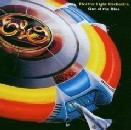
Electric Light Orchestra
Out of the Blue
(Jet/Legacy)
First Appeared in The Music Box, February 2007, Volume 14, #2
Written by John Metzger
![]()
Electric Light Orchestra (ELO) has taken a lot of flak over the years for its unwavering, self-indulgent approach to recording, and everything came to a head after the band issued its 1977 effort Out of the Blue. Packaged as a double album — the entirety of which fits squarely on a single CD and, hence, is no more expansive than a great many modern-day endeavors — the collection was overflowing with ideas, which Jeff Lynne was able to hold together (barely) with his larger-than-life production values and his recurring musical themes. Big Wheels, in particular, was a hodgepodge of recycled concepts — including portions of Sweet Talkin’ Woman and Telephone Line — and the end result was placed within a four-song suite entitled Concerto for a Rainy Day. As always, there also were liberal doses of The Beatles, The Beach Boys, and The Bee Gees drifting through Lynne’s compositions. Steppin’ Out, for example, served as a template for what he later would do with an unfinished demo of John Lennon’s Real Love on The Beatles’ Anthology project; Across the Border essentially rearranged Brian Wilson’s Heroes and Villains by adding some new scenery; and Starlight was pure soft-rock that was drawn straight from the Gibb brothers. In other words, there was some truth to the criticisms that had been leveled at both ELO and its work. Nevertheless, Out of the Blue ought not to be dismissed quite so readily.
There’s little doubt that ELO’s grand ambitions simultaneously clashed with and fueled its over-the-top excesses, but the material on Out of the Blue was delivered in such a straightforward and serious fashion that it inevitably succeeded simply because of Lynne’s belief that it could. The outing contained some of the group’s best work (the irresistible, supremely shiny pop of Mr. Blue Sky) as well as some of its worst (the vocoder-laced, space-filler Believe Me Now). In fact, the only place where Out of the Blue truly dragged was during its second side. What helped the rest of the affair to rise above its inherent flaws was the superb job that Lynne did with the effort’s sequencing. By scattering the obvious singles in amongst Out of the Blue’s lesser compositions, he gave ELO one final opportunity to silence its critics. In the end, his bid failed, and, perhaps, he would have fared better if he had given up on the notion of creating a double-LP. Providing consolation, fans were enthralled with the set, and they propelled it to #4 on both the U.S. and the U.K. charts.
While ELO did continue to tour and record, scoring several more hits in the process, it also began to struggle to find its niche within the changing music market. On its 1979 outing Discovery, the band embraced disco completely just as the genre was beginning to fade away, and when it finally got back to basics on its 1981 endeavor Time, it wasn’t really gaining new fans so much as it was keeping the older ones satisfied. In that sense, Out of the Blue was ELO’s last creative push as well as its final burst of glory.
Given the length of Out of the Blue, there is little room left for
bonus material. Two of the three tracks that are tacked onto the end of the
latest incarnation of the album — which, incidentally, sounds spectacular — are
mere snippets: a 24-second alternate bridge meant for Wild West Hero and
a short yet cinematic instrumental titled The Quick and The Daft. As for
Latitude 88 North, the third cut, Lynne struggled for years to finish the
tune, and recently completed, its chirpy reflection serves as a fitting ending
to the set. ![]()
![]()
![]() ½
½
Out of the Blue is available from
Barnes & Noble. To order, Click Here!
![]()
Ratings
1 Star: Pitiful
2 Stars: Listenable
3 Stars: Respectable
4 Stars: Excellent
5 Stars: Can't Live Without It!!
![]()
Copyright © 2007 The Music Box
